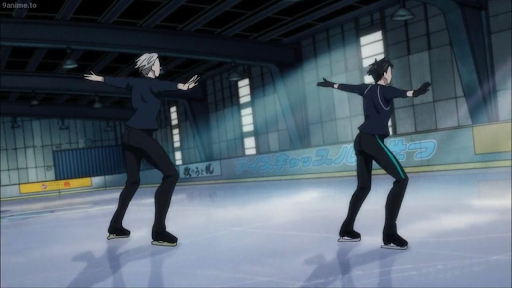Physics Blog


Thomas Li
Mar 05, 2022
Figure Skating - Electric Field & Energy
Introduction
Now, I want to investigate another jump that Yuzu made during his free skating (because the athletes would receive 1.1 times the technical score on the jumps if they make the jumps in the second half of their free skating, so Yuzu decided to make a lot of jumps here!). Something you need to take note of is that in this world, there exist many “anti-Olympians,” who are against the Olympics! And they are causing a lot of trouble in the figure skating competition…

Background Information
The anti-Olympians put a positive point charge right under the rink near the ice surface. Because there are some excess electrons on Yuzu, he is affected by the charge and doesn’t jump as high! This fact relates my question to physics because it now involves electric charge! Other concepts involved include the electric field that the charge creates on Yuzu, and the conservation of energy and electric potential energy because the charge is also affecting the flow of energy as Yuzu jumps.
Electric Charge: the physical property of matter that causes it to experience a force when placed in an electromagnetic field. There is an electric charge placed under the rink to interrupt Yuzu’s jump!
Electric Field: the electric force per unit charge and exists at a point. An electric field exists on Yuzu due to the charge under the rink.
Electric Potential Energy: the energy that is needed to move a charge against an electric field. This energy exists when calculating the flow in Yuzu’s conserved energy.
Equations:

→ Electric Charge Equation
- q is the charge of the particle
- N is the number of electrons on Yuzu
e is the charge of a single proton/electron, ±1.6 * 10^-19 C

→ Electric Field Equation
- E is the electric field
k is the constant 8.99 * 10^9 Nm^2/C^2
- q is the charge of the particle
r is the distance between the charge and Yuzu

→ Conservation of Energy Equation
- Eki is the initial kinetic energy
- Egi is the initial gravitational energy
- EEi is the initial electric energy
- Ekf is the final kinetic energy
- Egf is the final gravitational energy
- EEf is the final electric energy

→ Change in Electric Energy Equation
- ΔEE is the change in electric energy
- WAB is the work done on Yuzu
- q0 is the charge of the particle
- E is the electric field on Yuzu
- d is the distance between the charge and Yuzu
Assumption: Ignore air resistance!
Units: Follow convention units for all the variables to ensure consistency and accuracy.

Question 3
The athletes would receive 1.1 times the technical score on the jumps if they make the jumps in the second half of their free skating. Due to this rule, Yuzu decides to do a quadruple toeloop jump (4T) at the end of the second half! However, some anti-Olympians are trying to make him fail his jump! They put a positive point charge right under the rink near the surface. Because there are 1.5 x 10^14 excess electrons on Yuzu, he is affected by the charge. He doesn’t jump as high and only completes a triple toeloop jump (3T). Thomas is mad and he wants to sue the anti-Olympians for breaking the rule! The judges are helping Thomas by telling him the maximum height of Yuzu’s jump is 0.47 metres. Ignore air resistance.
a) Thomas needs to find out the electric field on Yuzu when he was at the maximum height in his 3T jump as evidence on the court. Help Thomas find the evidence!
b) Thomas needs another piece of evidence! Can you help him find Yuzu’s vertical landing velocity in this jump?
To solve part a, we need to first determine the given and required information, and draw out a diagram to model the effect of the charge on Yuzu (since no forces are involved, no FBD is needed).

General steps to solve this question:
1) Use the electric charge equation and sub in values to solve for q
2) Use the electric field equation, then sub in q that we just got
3) Sub in all other known values to solve for |E|

As you can see, I used the equation q = Ne and plugged in the given N and the constant e to get q = 2.4 * 10^-5 C as my middle step.

Then, I plugged in all the values, including q I just got, into the electric field equation.

The result I got was 9.77 * 10^5 N/C as the electric field on Yuzu. The direction is down because the electric field is pointing down.
Now, let’s solve part b!
General steps to solve this question:
1. Because energy is conserved, set Ei = Ef
2. Expand the equation and cross out Eki and mghf because vi and hf are both zero
3. Rearrange the remaining terms so that EEf - EEi is formed, which turns into -q0Ed according to the change in electric energy equation
4. Isolate for vf (a bit complicated…) .
5. Sub in all values to solve for vf

Write out all given and required information, and draw out a diagram to model the effect of the charge on Yuzu (since no forces are involved, no FBD is needed).

As you can see, I set up the conservation of energy equation and realized I could cancel out the terms Eki and Egf because I set the maximum height Yuzu reaches in his jump to be the initial point and his landing point to be the final point. This makes the calculations easier and turns the 2 terms above 0.

Then, I rearranged the remaining terms and combined EEf - EEi to be ΔEE, which is the same as -q0Ed. I rearranged again to isolate for vf. The process is complicated but I can now solve for the vertical landing velocity I want to find.

I finally plugged in all the given values to get vf = 3.10 m/s. The direction is down because Yuzu is going downwards when landing on ice.
Summary
This is the end of my blogs! Hopefully, you have gained some Grade 12 Physics knowledge by reading my blogs. And I also hope that you could become a fan of Yuzuru Hanyu because he skates so well and is so elegant! Or, at least, I hope you have become more interested in skating or figure skating, but be careful if you want to try those moves and jumps… Anyways, thank you so much for taking your time to read my blogs!

Thomas Li
Thomas is a Grade 12 student from Crestwood Preparatory College who is passionate about mathematics and physics